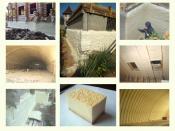Search
Login
MDF panels, application, choose the right MDF panels, methods of installation and fastening, useful tips
To get an attractive wall design, to provide comfort in the room and an environmentally friendly environment in it, perhaps with the help of modern finishing material - MDF. Its release is in the form of panels. He gained fame extremely quickly, due to its practicality and attractiveness, its use is allowed in rooms with extreme loads: kitchen, living room, hallway. MDF panels surprise with a variety of shades and textures, they can very accurately imitate natural wood materials, brickwork or tile. The cost of the material is low, with its independent installation it is possible to obtain significant savings in finishing work, during operation it will not be particularly difficult to take care of it.
Content
- Wall MDF panels, their properties and advantages
- Types of MDF panels
- We purchase MDF panels and materials that will be required during installation work video
- MDF paneling - workflow
- Methods of fixing MDF boards video
- MDF panels for the kitchen - are they suitable material video
- MDF board care
Wall MDF panels, their properties and advantages

To begin with, we note that MDF panels are not made from solid wood, but from waste, while no synthetic impurities or adhesives are used, the technological process consists in heating wood chips to high temperatures and pressing it under high pressure. Durable bonding of material fragments occurs due to the lignin released during heating of the natural polymer compound.
Among the important advantages of MDF panels should be noted:
- environmental friendliness of the material
- possibility of quick and easy installation,
- good heat and noise insulation characteristics,
- material strength, long service life,
- ease of replacing any piece of trim if necessary,
- simple care that does not require the purchase of expensive chemicals,
- the ability to hide wires, pipes, other utilities under a layer of cladding,
- affordable cost of material.

The main disadvantages of the panels are:
- flammability of the material - when laying electrical wiring under the plates, they will need to be carefully insulated in a self-extinguishing corrugation,
- inability to use in conditions of high humidity,
- fragility, the need for very careful handling during installation work.
Types of MDF panels

In the manufacture of panels using different methods of finishing the front side, respectively, the panels themselves are divided into two types:
- laminated, the surface of which is covered with PVC film, characterized by an attractive appearance, imitating the structure of natural wood, other building materials, not prone to dust accumulation, resistant to damage;
- veneered, for the finish of which veneer of the best wood species is used.

The exterior finish of the panels can be shiny - glossy or matte.
We purchase MDF panels and materials that will be required during installation work

Although the installation of MDF panels is not a difficult process, nevertheless, it will require preliminary preparation, purchase of the facing material and the necessary components. In order to correctly calculate the number of panels, you should first of all take into account the width of the space to be trimmed. MDF-panel sizes are as follows: their standard width is 148, 190, 240 mm. Determining the required number of panels is simple: this will be the quotient of dividing the width of the wall by the width of the panel. You should buy a little more material than was calculated: defects may get caught, part of it will go to trimmings, losses can occur as a result of errors.
To work, you need to stock:
- MDF panels
- insulating corrugation, if the wiring is laid under the panels,
- self-tapping screws
- ceiling lights,
- suspensions
- klemera
- profiles
The preparation of the walls will consist in cleaning them from the remnants of old wallpaper. You will also have to remove the skirting boards. The surface of the walls must necessarily be treated with an antifungal primer, especially for rooms with increased humidity. If necessary, the walls can be pasted over with insulation material, for example, foamed A foil. It is fastened with glue, butt, with a foil side inside the room.

The use of finishing corners will be greatly simplified by the installation. Consisting of plaques arranged with a gap of 2 mm, they are intended for fastening strips; a film corresponding to the color of the panels is applied to their surface. The angle formed is very easy to bend outward or inward. This point is especially important if the geometry of the available angles is far from ideal.
To build a frame for the cladding you will need slats, preferably 20x40 mm. It makes no sense to use rails with a large cross section - the panels have a small weight. In addition, rails with this cross section are constantly available in construction stores. Fasteners rails can be done with plastic dowels and wood screws.
To fasten the MDF panels to the bars of the frame, kleimers will be required, most often they are sold complete with panels. It will be convenient to glue the corners with liquid nails. The quality of the glue should be discussed especially - since the panels can change under the influence of moisture and temperature, then the glue for them should have some plasticity. Such characteristics of the adhesive are usually indicated on its packaging. In addition, the glue should have a texture that allows it to be applied with a thicker or very thin layer - depending on the curvature present on the walls. Liquid nails comply with these requirements.
The installation of the crate should be carried out with a check of the evenness of the structure, for which you can use the usual building level.

Before attaching the MDF panels, it is imperative to make sure the quality of the installation of the battens - this will ultimately determine the general appearance of the walls. To fasten the panels to the crate, kleimers are used.
Those who decide to do their own MDF paneling should not neglect the following recommendations:
- If it is necessary to cut the panels, it is best to use a jigsaw - the cut will be even and clear. Here it should be remembered that milling, grinding and drilling of panels is quite simple to perform, while the tools will fit the same ones that are used in the processing of wood materials.
- In rooms with a high level of humidity, the frame is best made of a metal profile. If the crate is made of wood, then it should be treated with high-quality antifungal impregnations.
- If it is planned to finish the joint of the ceiling and walls with a skirting board, then before mounting the panels around the room perimeter, the mounting device is installed. After mounting the plates, a ceiling plinth is installed in its groove.
- In places of the alleged placement of hinged interior items, it will be necessary to strengthen the frame with additional bars.
MDF paneling - workflow
The installation of the battens begins from the most convex place on the wall. The bars are mounted in a horizontal direction, in increments of not more than 40 cm. Increasing the pitch can lead to distortion of the pattern.

The fastening of the strips should begin from the corner, it is desirable to make the calculation so that the last panel remains intact. Before starting installation work, you can repeat the calculations or even try on how the acquired material will lie on the wall. The spike of the first panel should be in the corner.

The length of each panel will require the use of 5-6 mounting clamps. They are distributed evenly and fastened with a screwdriver to the rails. Fixation of the opposite end is carried out using self-tapping screws.

So that the self-tapping screw head is buried in the material, you must first drill a hole with a diameter of 8-10 mm in the bar. The subsequent strip is fastened with a spike into the groove of the previous one, this procedure is repeated until the last one is installed. Each of the joints at the joints, the side and top edges are fixed with corners, on liquid nails.
If the option of laying panels in the horizontal or diagonal direction is chosen, then the direction of the crate should be changed - its strips should be perpendicular to the panels of the facing material.
All detected significant depressions on the walls should be laid with blocks or wedges.
From below, the joints of the slabs are covered with an ordinary baseboard, it can be fixed with nails or put on a sealant. For ease of fixing the baseboard, the lower battens of the battens are fixed at floor level. A joint under the ceiling can be decorated with a corner or baseboard.
Methods of fixing MDF boards

Methods of fixing MDF boards can be different, depending on the state of the concrete surface on which the installation is performed. If it is aligned and clean, then the panels can be glued directly to the wall using adhesive sealant.

It is applied in a zigzag pattern across the board, then it is firmly pressed against the wall for a couple of seconds. If excess glue comes out - they are carefully removed with a spatula.
If a layer of insulation will be laid under the MDF boards or numerous engineering communications will have to be hidden under it, then the best option would be to install the boards on a metal frame.

If you need to hide noticeable irregularities in the wall, it is better to use a crate made of wooden beams - it will be stronger and more stable. In places where sockets or switches are installed, holes of the required diameter should be made with an electric drill.
MDF panels for the kitchen - are they suitable material

You can often find a discussion on the topic of installing MDF panels in a kitchen room. It is not easy to give a definite answer to it. MDF is an environmentally friendly material, it does not have an unpleasant odor, therefore it can not do any harm to people in the kitchen.
At the same time, the material is not moisture resistant to the extent that it would allow its unhindered installation in rooms with a high level of humidity - under the influence of water, the material may lose its attractive appearance. But to refine with the help of MDF-plates areas remote from places where water is used, for example, the dining area, it is still possible. At the same time, it is recommended to fasten the panels on a metal profile - wood in a humid environment can suffer from fungi and putrefactive processes. In addition, experts recommend paying attention to a relatively new version of panels with a special moisture-resistant coating.
MDF board care

The period of operation of the plates will not cause much trouble. The surface of the plates is very smooth, it is well laminated and coated with paints. The material is cleaned of contaminants with a moistened soft rag; substances containing abrasive particles cannot be used during cleaning.
If during operation it becomes noticeable peeling of the top coating of the film, then it can be removed using fine-grained sandpaper. Any of the damaged boards can be replaced quite easily with a new one.





